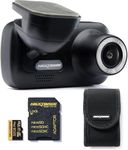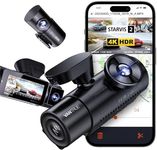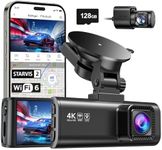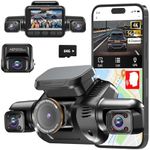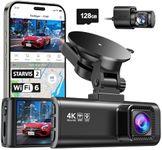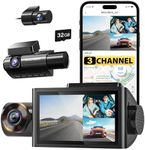Buying Guide for the Best Dash Cameras
Dash cameras, also known as dashboard cameras, are essential tools for recording your driving experience. They can provide crucial evidence in the event of an accident, help with insurance claims, and even capture unexpected moments on the road. When choosing a dash camera, it's important to consider various features that will best suit your driving habits and needs. Understanding these features will help you make an informed decision and ensure you get the most out of your purchase.ResolutionResolution refers to the clarity and detail of the video footage captured by the dash camera. Higher resolution means clearer images, which can be crucial for identifying license plates and other details in the event of an incident. Common resolutions include 720p, 1080p, and 4K. If you drive frequently in busy areas or want the best possible image quality, opt for 1080p or 4K. For basic recording needs, 720p may suffice.
Field of ViewThe field of view (FOV) is the extent of the observable area captured by the camera. A wider FOV can capture more of the surroundings, which is beneficial for recording incidents that occur to the sides of your vehicle. Typical FOV ranges from 120 to 180 degrees. If you drive in congested areas or want comprehensive coverage, a wider FOV is preferable. For straightforward front-view recording, a narrower FOV might be adequate.
Night VisionNight vision capability allows the dash camera to record clear footage in low-light conditions. This is important for capturing details during nighttime driving or in poorly lit areas. Cameras with infrared LEDs or advanced sensors offer better night vision. If you often drive at night or in dimly lit environments, prioritize a dash camera with strong night vision capabilities.
Storage CapacityStorage capacity determines how much video footage the dash camera can hold before it starts overwriting old files. This is usually managed through microSD cards, with capacities ranging from 16GB to 256GB or more. If you drive long distances or want to keep footage for extended periods, consider a larger storage capacity. For shorter trips or frequent file transfers, a smaller capacity may be sufficient.
Loop RecordingLoop recording is a feature that allows the dash camera to continuously record by overwriting the oldest footage when the storage is full. This ensures that the camera is always recording, which is crucial for capturing unexpected events. Most dash cameras have this feature, but it's important to check if it can be adjusted to different time intervals. Choose a camera with loop recording if you want hassle-free, continuous recording without manual file management.
G-SensorA G-sensor detects sudden movements or impacts and automatically saves the footage from being overwritten. This is vital for preserving evidence in the event of an accident. The sensitivity of the G-sensor can often be adjusted. If you want to ensure critical moments are captured and saved, look for a dash camera with a reliable G-sensor.
GPSGPS functionality in a dash camera records your vehicle's location and speed alongside the video footage. This can be useful for verifying your location during an incident or for tracking your routes. If you need detailed travel logs or want to add context to your recordings, consider a dash camera with built-in GPS.
Wi-Fi ConnectivityWi-Fi connectivity allows you to connect the dash camera to your smartphone or other devices for easy access to footage and settings. This can be convenient for quickly reviewing or sharing videos. If you prefer seamless integration with your devices and easy file management, look for a dash camera with Wi-Fi capabilities.






